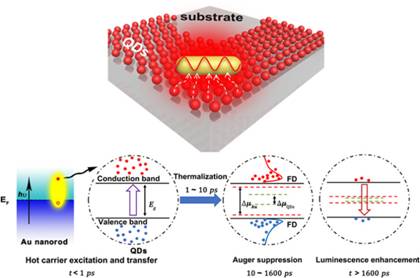Prof. Hongqiang Wang and associate Prof. Hongyue Wang group (School of Materials Science and Engineering, Northwestern Polytechnical University), in collaboration with Prof. Hongtao Bian (School of Chemistry and Chemical Engineering, Shaanxi Normal University), Prof. Herve Aubin (Department of Nanoelectronics Center for Nanoscience and Nanotechnology, CNRS, University Paris-Saclay), associate Prof. Taihong Liu (School of Chemistry and Chemical Engineering, Shaanxi Normal University), and Prof. Aloyse Degiron (Université de Paris, CNRS, Laboratoire Matériaux et Phénomènes Quantiques,) recently published a paper entitled “Bright CdSe/CdS Quantum Dot Light-Emitting Diodes with Modulated Carrier Dynamics via the Local Kirchhoff Law” on ACS Applied Materials Interfaces (2021) 13: 56476-56484. In this research, they reported the investigation of coupling between Au antennas and the quantum dot (QD) assembly within the framework of the local Kirchhoff law, which shows that the amplitude of light emission depends on the carrier concentration and decay. The Au antennas inject hot electrons into quantum dot assemblies via plasmon-induced hot electron transfer that increases the carrier concentration, and the localized surface plasmon resonances of Au antennas favorably tilt the balance between nonradiative Auger processes and radiative recombination in the CdSe core, as illustrated in Figure 1.

Figure 1 Antenna-modulated carrier dynamics of the CdSe core.
Addressing the interactions between optical antennas and ensembles of emitters is particularly challenging. Charge transfer and Coulomb interactions complicate the understanding of the carrier dynamics coupled by antennas. The central questions about the coupling between nanoantennas with emitter assembly that have not yet been addressed are the following: (i) how do these carrier dynamics processes influence the luminescence of ensembles of emitters within the framework of the local Kirchhoff law? (ii) how do these viewpoints apply for designing efficient solution-processed LEDs? In this work, they investigate these questions with Au antennas that boost the light emission of QD assemblies through modifications of the carrier dynamics within the framework of the local Kirchhoff law and construct the QD light-emitting diodes by combining with antennas. The results presented in this work suggest a new understanding of light emission of assembled emitters coupled by antennas, which is of essential interest for the description of light-matter interaction in advanced optoelectronics. The main novelties of present work are as following:
1. This work shows that the chemical potential depends of time through plasmonic-induced hot electron transfer that controls the initial difference of the chemical potentials, and localized surface plasmonic resonances that controls the decay of the chemical potentials with time. This time evolution of the chemical potentials controls the luminescence of the ensemble of emitters, which demonstrate the validity of the local Kirchhoff law.
2. A high bright (125,091.6 cd/m2) deep-red quantum dot light-emitting diode is obtained by combining with Au antennas.
Prof. Hongqiang Wang group in School of Materials Science and Engineering, Northwestern Polytechnical University, has been working on transient extreme conditions including PLICN (pulsed laser irradiation of colloidal nanoparticle) and interfacial sonochemistry, and their application in energy applications. His research team is now focusing on laser-matter interactions for energy applications including Perovskite Solar Cells, Lithium Batteries, PEC Water Splitting, as well as LEDs. Associate Prof. Hongyue Wang focus on colloidal nanocrystals synthesis and LEDs design. In this work, Prof. Hongqiang Wang and associate Prof. Hongyue Wang are the corresponding authors, associate Prof. Hongyue Wang and Yangyang Guo are the co-first authors. This work is supported by NSFC (Nos. 52011530432, 51911530212 and 51902263), the Natural Science Foundation of Shaanxi Province (2020JQ-158), the Fundamental Research Funds for the Central Universities (3102019JC005, 3102019ghxm004 and GK202001009), the Joint Research Funds of Department of Science & Technology of Shaanxi Province and Northwestern Polytechnical University (2020GXLH-Z-018) and the 1000 Youth Talent Program of China.
The article link is as follows: https://doi.org/10.1021/acsami.1c17152
Author: Hongyue Wang
Reviewer: Hongqiang Wang,Wei Liu